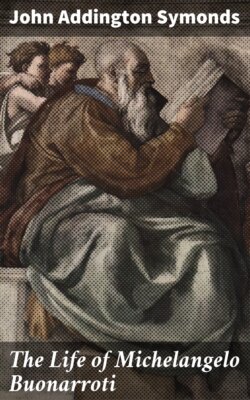Читать книгу The Life of Michelangelo Buonarroti - John Addington Symonds - Страница 29
На сайте Литреса книга снята с продажи.
ОглавлениеWe have every reason to regard the composition of this Cartoon as the central point in Michelangelo's life as an artist. It was the watershed, so to speak, which divided his earlier from his later manner; and if we attach any value to the critical judgment of his enthusiastic admirer, Cellini, even the roof of the Sistine fell short of its perfection. Important, however, as it certainly is in the history of his development, I must defer speaking of it in detail until the end of the next chapter. For some reason or other, unknown to us, he left his work unfinished early in 1505, and went, at the Pope's invitation, to Rome. When he returned, in the ensuing year, to Florence, he resumed and completed the design. Some notion of its size may be derived from what we know about the material supplied for Lionardo's Cartoon. This, say Crowe and Cavalcaselle, "was made up of one ream and twenty-nine quires, or about 288 square feet of royal folio paper, the mere pasting of which necessitated a consumption of eighty-eight pounds of flour, the mere lining of which required three pieces of Florentine linen."
Condivi, summing up his notes of this period spent by Michelangelo at Florence, says: "He stayed there some time without working to much purpose in his craft, having taken to the study of poets and rhetoricians in the vulgar tongue, and to the composition of sonnets for his pleasure." It is difficult to imagine how Michelangelo, with all his engagements, found the leisure to pursue these literary amusements. But Condivi's biography is the sole authentic source which we possess for the great master's own recollections of his past life. It is, therefore, not improbable that in the sentence I have quoted we may find some explanation of the want of finish observable in his productions at this point. Michelangelo was, to a large extent, a dreamer; and this single phrase throws light upon the expanse of time, the barren spaces, in his long laborious life. The poems we now possess by his pen are clearly the wreck of a vast multitude; and most of those accessible in manuscript and print belong to a later stage of his development. Still the fact remains that in early manhood he formed the habit of conversing with writers of Italian and of fashioning his own thoughts into rhyme. His was a nature capable indeed of vehement and fiery activity, but by constitution somewhat saturnine and sluggish, only energetic when powerfully stimulated; a meditative man, glad enough to be inert when not spurred forward on the path of strenuous achievement. And so, it seems, the literary bent took hold upon him as a relief from labour, as an excuse for temporary inaction. In his own art, the art of design, whether this assumed the form of sculpture or of painting or of architecture, he did nothing except at the highest pressure. All his accomplished work shows signs of the intensest cerebration. But he tried at times to slumber, sunk in a wise passiveness. Then he communed with the poets, the prophets, and the prose-writers of his country. We can well imagine, therefore, that, tired with the labours of the chisel or the brush, he gladly gave himself to composition, leaving half finished on his easel things which had for him their adequate accomplishment.
I think it necessary to make these suggestions, because, in my opinion, Michelangelo's inner life and his literary proclivities have been hitherto too much neglected in the scheme of his psychology. Dazzled by the splendour of his work, critics are content to skip spaces of months and years, during which the creative genius of the man smouldered. It is, as I shall try to show, in those intervals, dimly revealed to us by what remains of his poems and his correspondence, that the secret of this man, at once so tardy and so energetic; has to be discovered.
A great master of a different temperament, less solitary, less saturnine, less sluggish, would have formed a school, as Raffaello did. Michelangelo formed no school, and was incapable of confiding the execution of his designs to any subordinates. This is also a point of the highest importance to insist upon. Had he been other than he was—a gregarious man, contented with the à peu près in art—he might have sent out all those twelve Apostles for the Duomo from his workshop. Raffaello would have done so; indeed, the work which bears his name in Rome could not have existed except under these conditions. Now nothing is left to us of the twelve Apostles except a rough-hewn sketch of S. Matthew. Michelangelo was unwilling or unable to organise a band of craftsmen fairly interpretative of his manner. When his own hand failed, or when he lost the passion for his labour, he left the thing unfinished. And much of this incompleteness in his life-work seems to me due to his being what I called a dreamer. He lacked the merely business faculty, the power of utilising hands and brains. He could not bring his genius into open market, and stamp inferior productions with his countersign. Willingly he retired into the solitude of his own self, to commune with great poets and to meditate upon high thoughts, while he indulged the emotions arising from forms of strength and beauty presented to his gaze upon the pathway of experience.
